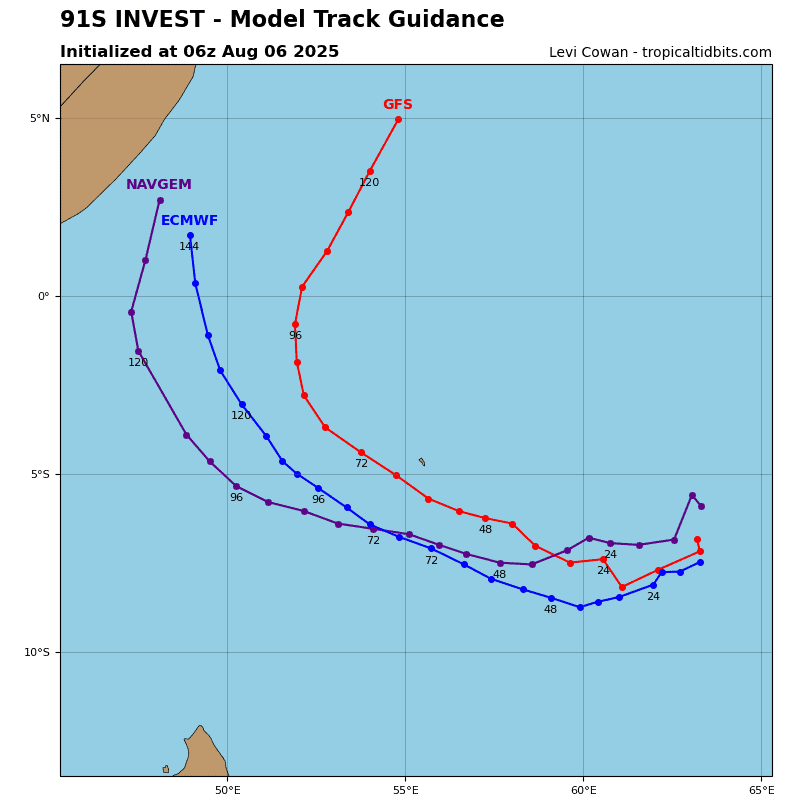Current Snapshot
For all the latest updates visit: DisasterAWARE
By PDC’s Senior Weather
Specialist Glenn James

The Pacific Disaster Center’s (PDC Global) Friday, March 8, 2024, Tropical Cyclone Activity Report…for the Pacific Ocean, the Indian Ocean, and adjacent Seas
Current Tropical Cyclones:
There are no Tropical Cyclones…although there’s three areas of disturbed weather being referred to as Invest 90S and Invest 91S in the South Indian Ocean, and Invest 92P in the southwest Pacific Ocean
Northeast Pacific Ocean:
The North Pacific hurricane season officially ended on November 30, 2023. Routine issuance of the Tropical Weather Outlook will resume on May 15, 2024. During the off-season, Special Tropical Weather Outlooks will be issued as conditions warrant.
The eastern Pacific basin hurricane season was above normal, with 17 named storms, of which 10 were hurricanes and eight of those major hurricanes.
From August 16 to 21, Tropical Storm Hilary brought widespread heavy rainfall and flooding to Southern California, with some areas receiving up to 600% of their normal August rainfall. Hilary resulted in the first ever issuance of Tropical Storm Watches and Warnings for the Southern California coastline by NOAA’s National Hurricane Center. In addition, the Center distributed key hazard focused messages for Hilary in Spanish through the agency’s new language translation project.
Hurricane Otis made landfall near Acapulco, Mexico, on October 25 as a category-5 hurricane, with sustained winds of 165 mph. Otis holds the record as the strongest land falling hurricane in the eastern Pacific, after undergoing rapid intensification in which wind speeds increased by 115 mph in 24 hours.
Central North Pacific:
The central North Pacific hurricane season officially ended on November 30, 2023. Routine issuance of the Tropical Weather Outlook will resume on June 1, 2024. During the off-season, Special Tropical Weather Outlooks will be issued as conditions warrant.
The central Pacific basin had a near-normal season with four tropical systems traversing the basin.
Hurricane Dora, a category-4 storm, passed south of Hawaii in early August, marking the first major hurricane in the central Pacific basin since 2020. The strong gradient between a high pressure system to the north and Dora to the south was a contributing factor to the wind-driven, fast-moving wildfires in Hawaii.
Western Pacific, Indian Ocean and adjacent Seas
South Indian Ocean…
>>> There’s an area of disturbed weather being referred to as Invest 90S…which is located approximately 86 NM southeast of Europa Island.
Animated enhanced infrared satellite imagery, and a microwave image depict a partially exposed low level circulation center with flaring convection to the northeast of the circulation.
Environmental analysis reveals a marginally favorable environment for further development with low (10-15 knot) vertical wind shear, good upper-level outflow equatorward, and warm sea surface temperatures. Invest 90S is being influenced by a dry air mass wrapping into the circulation from the west and which is the primary limiting factor for development.
Global deterministic models are in good agreement that invest 90S will continue to weaken in the Mozambique Channel as it approaches the coast of Africa.
Maximum sustained surface winds are estimated at 18 to 22 knots.
The potential for the development of a significant tropical cyclone within the next 24 hours remains low.
>>> There’s a second area of disturbed weather being referred to as Invest 91S…which is located approximately 330 NM west-northwest of Cocos Island.
Animated enhanced infrared satellite imagery, a microwave image depict an elongated low-level circulation hidden underneath flaring convection.
Environmental analysis shows a marginally unfavorable environment for further development with moderate to high (20-25 knot) vertical wind shear, weak upper-level outflow, offset by warm sea surface temperatures.
Global models are in agreement that 91S will continue an east-southeastward track towards a marginally favorable environment and strengthening over the next 48 hours.
Maximum sustained surface winds are estimated at 23 to 28 knots.
The potential for the development of a significant tropical cyclone within the next 24 hours is low
Southwest Pacific Ocean…
>>> There’s a third area of disturbed weather being referred to as Invest 92P…which is located approximately 148 NM northwest of Port Vila, Vanuatu.
The system is currently classified as a subtropical cyclone, generally characterized as having both tropical and mid-latitude cyclone features. The system is located under the leading edge of a deep upper level subtropical trough with 30-40 knot northwesterlies over the center. The deep moisture profile is highly asymmetric, with extensive dry air over the western quadrant.
Animated multi-spectral satellite imagery depicts a broad, asymmetric subtropical system with multiple mesovortices embedded in the elongated center. A microwave image reveals an asymmetric convective structure, with a linear band of deep convection associated with the strong low-level convergent flow along the northern and eastern peripheries of the system.
A broad circulation with weak core winds (5-10 knots), convergent gale-force strength northwesterly to northerly winds near Vanuatu, and significantly weaker winds displaced to the southwest.
Global models indicate a southeastward track over the next two days with near gale-force winds persisting over the northeastern semicircle.
Maximum sustained surface winds are estimated at 30 to 35 knots.
The potential for the development of a significant tropical cyclone within the next 24 hours is low.







